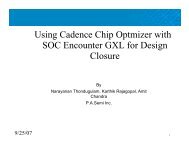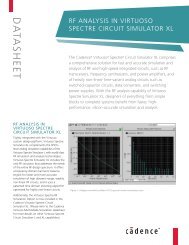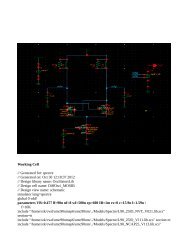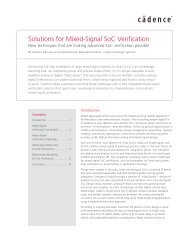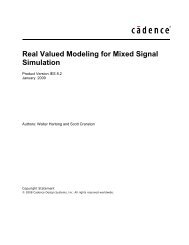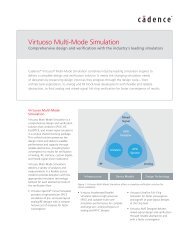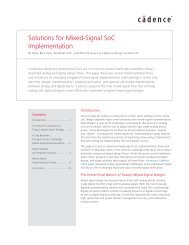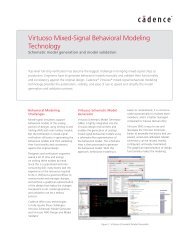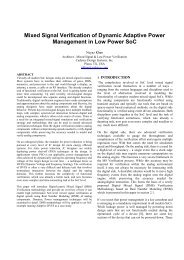Affirma Spectre DC Device Matching Analysis Tutorial - Cadence ...
Affirma Spectre DC Device Matching Analysis Tutorial - Cadence ...
Affirma Spectre DC Device Matching Analysis Tutorial - Cadence ...
You also want an ePaper? Increase the reach of your titles
YUMPU automatically turns print PDFs into web optimized ePapers that Google loves.
<strong>Affirma</strong> <strong>Spectre</strong> <strong>DC</strong> <strong>Device</strong> <strong>Matching</strong> <strong>Analysis</strong> <strong>Tutorial</strong><br />
vector z such that<br />
or<br />
(EQ 11)<br />
(EQ 12)<br />
After computing the vector z through a “transpose solve” in (12), the sensitivity of the<br />
output with respect to each transistor current can be computed with one extra vector<br />
product:<br />
(EQ 13)<br />
and finally, σ would be the variance of the output, where n is<br />
2( Vout)<br />
zT ( mi) 2 σ2 =<br />
∑ ( ΔIdsi) the number of devices.<br />
z T<br />
∂<br />
ΔIdsi In the equations above, the bjt and the resistor contributions to the mismatch should<br />
be added.<br />
3. Finding Model Parameters.<br />
n<br />
i = 1<br />
=<br />
T f( x)<br />
y ∂<br />
--------------<br />
∂x<br />
∂ f( x)<br />
--------------<br />
∂x<br />
T<br />
z = y<br />
To determine dcmatch model parameters, users have to go to their foundry or<br />
modeling group, study the statistical process, then do a regression analysis. We will<br />
give an example of how to use the concept of curve fitting to find model parameters.<br />
The actual procedure may vary significantly and is a matter of art. We will only<br />
introduce the concept. In general, to find parameters is not a trivial task.<br />
Lets assume we want to find out the parameters mvtwl, mvtwl2, and mvt0, which are<br />
used in the model equation<br />
Release Date Back Page 19<br />
Close<br />
19<br />
– 1<br />
Vout – z<br />
T = mi






